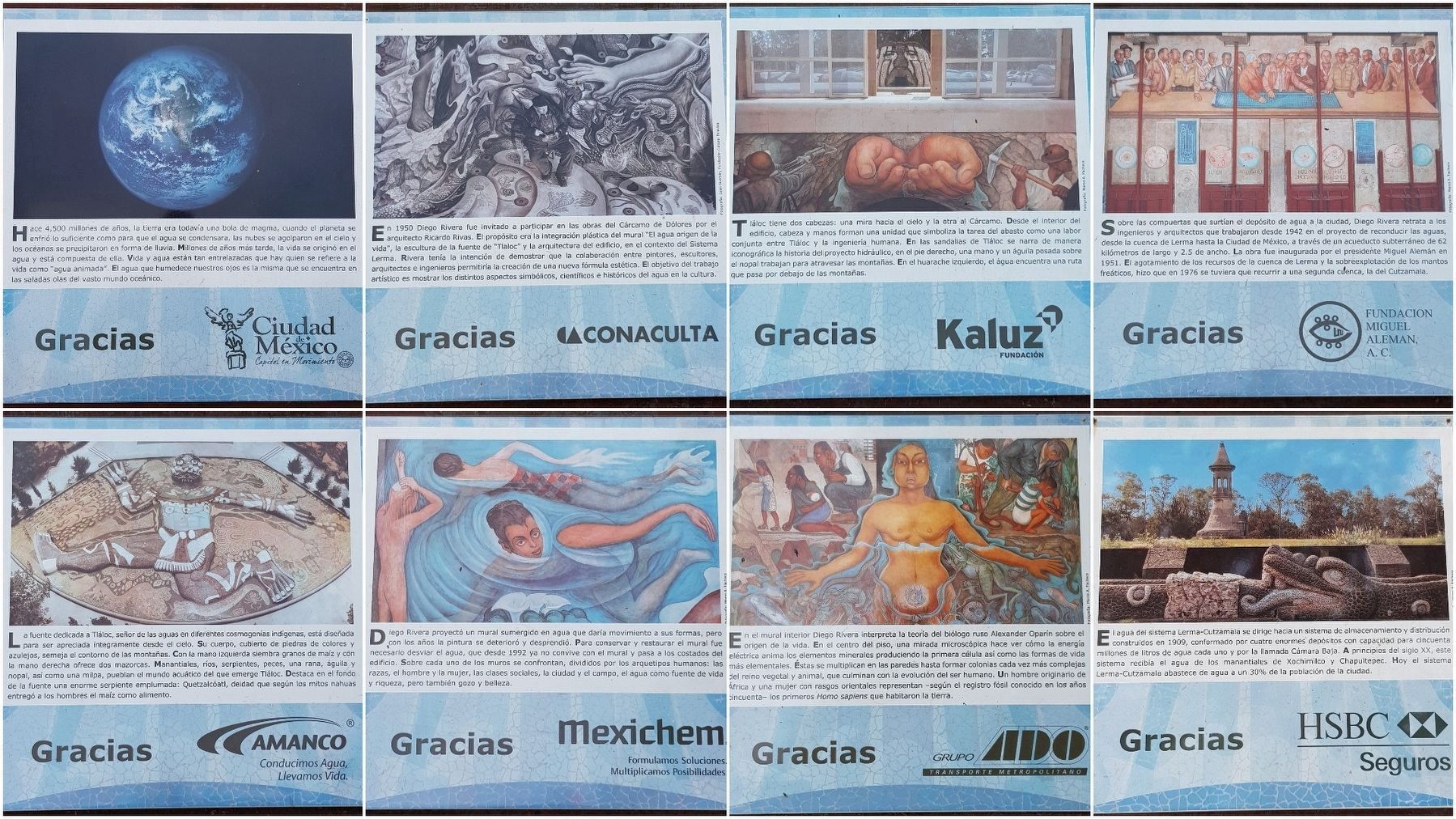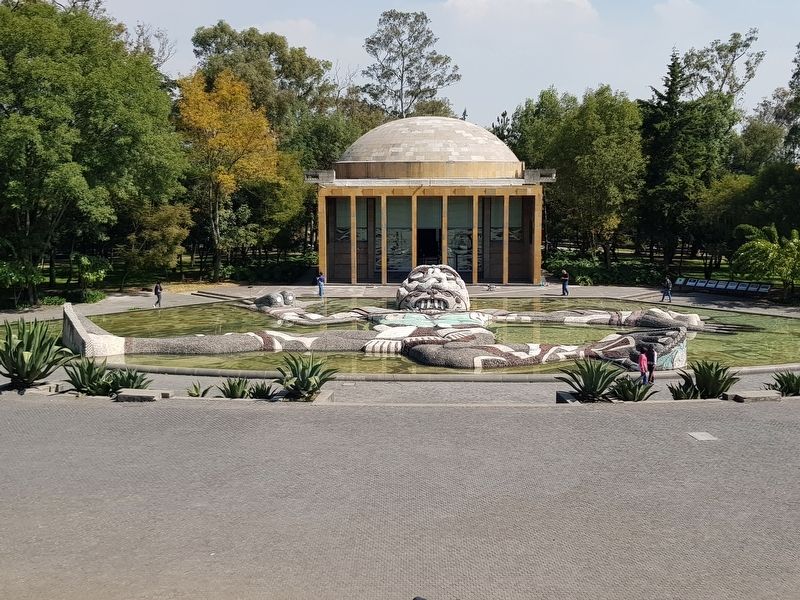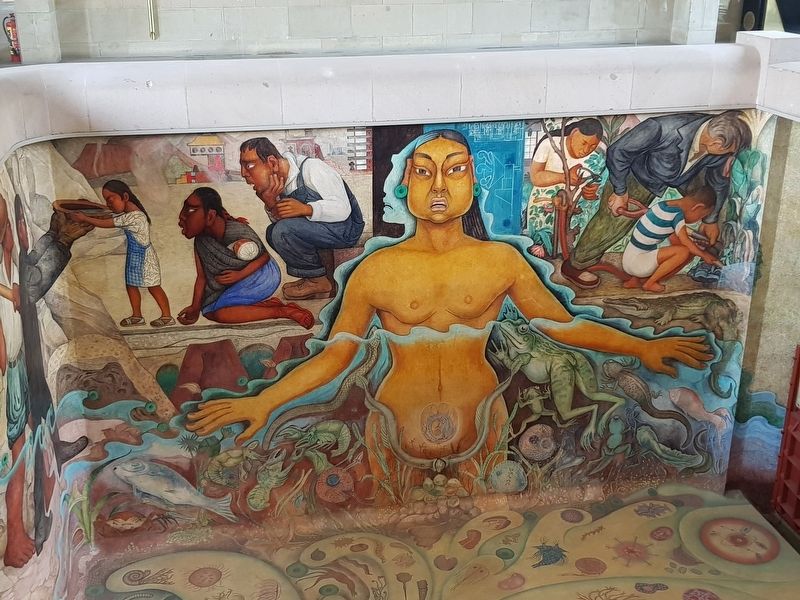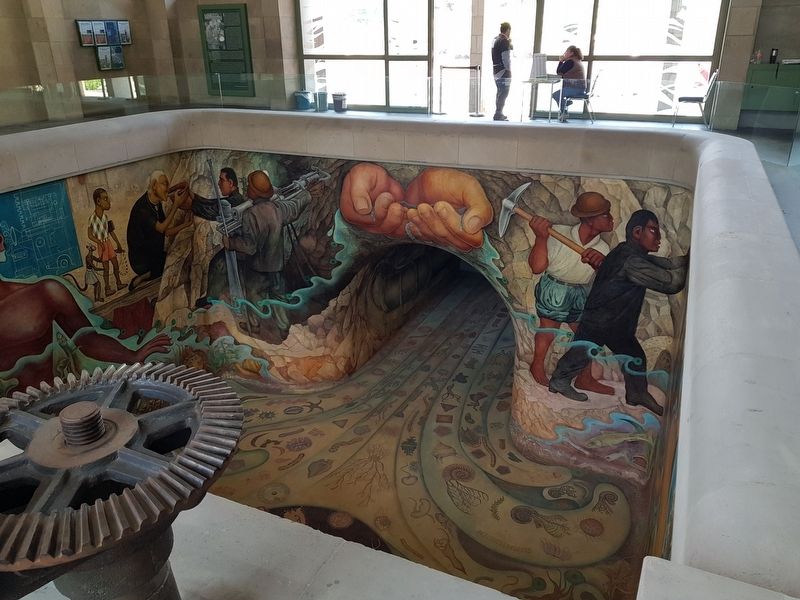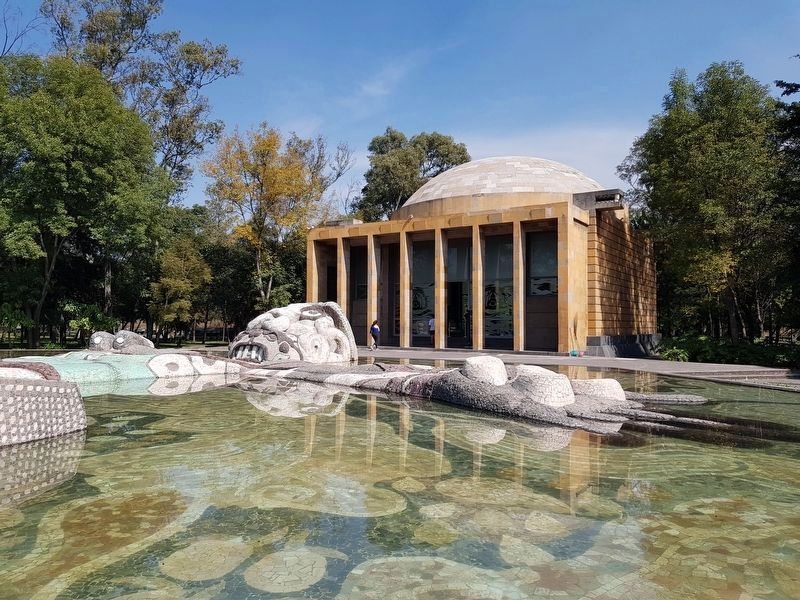Colonia Bosque de Chapultepec II Sección in Ciudad de México, Mexico — The Valley of Mexico (The Central Highlands)
El Cárcamo de Dólores
The Dolores Water Tank and Rivera Murals
Inscription.
En 1950 Diego Rivera fue invitado a participar en las obras del Cárcamo de Dólores por el arquitecto Ricardo Rivas. El propósito era la integración plástica del mural “El agua origen de la vida”, la escultura de la fuente de “Tlaloc” y la arquitectura del edificio, en el contexto del Sistema Lerma. Rivera tenía la intención de demostrar que la colaboración entre pintores, escultores, arquitectors e ingenieros permitiría la creación de una nueva fórmula estética. El objetivo del trabajo artístico es mostrar los distintos aspectos simbólicos, científicos e históricos del agua en la cultura.
Tláloc tiene dos cabezas: una mira hacie el cielo y la otra al Cárcamo. Desde el interior del edificio, cabez y manos forman una unidad que simboliza la tarea del abasto como una labor conjunta entre Tláloc y la ingeniería humana. En las sandalias de Tláloc se narra de manera iconográfica la historia del proyecto hidráulico, en el pie derecho, una mano y un águila posada sobre el nopal trabajan para atravesar las montañas. En el huarache izquierdo, el agua encuentra una ruta que pasa por debajo de las montañas.
Sobre las compuertas que surtían el depósito de agua a la ciudad, Diego Rivera retrata a los ingenieros y arquitectos que trabajaron desde 1942 en el proyecto de reconducir las aguas, desde la cuenca de Lerma hasta la Ciudad de México, a través de un acueducto subterráneo de 62 kilómetros de largo y 2.5 de ancho. La obra fue inaugurada por el presidente Miguel Alemán en 1951. El agotamiento de los recursos de la cuenca de Lerma y la sobreexplotación de los mantos freáticos, hizo que en 1976 se tuviera que recurrir a una segunda cuenca, la del Cutzamala.
La Fuente dedicada a Tláloc, señor de las aguas en diferentes cosmogonías indígenas, está diseñada para ser apreciada íntegramente desde el cielo. Su cuerpo, cubierto de piedras de colores y azulejos, semeja el contorno de las montañas. Con la mano izquierda siembre granos de maíz y con la mano derecha ofrece dos mazorcas.
Manantiales, ríos, serpientes, peces, una rana, águila y nopal, así como una milpa, pueblan el mundo acuático del que emerge Tláloc. Destaca en el fondo de la fuente una enorme serpiente emplumada: Quetzalcoátl, deidad que según los mitos nahuas entregó a los hombres el maíz como alimento.
Diego Rivera proyectó un mural sumergido en agua que daría movimiento a sus formas, pero con los años la pintura se deterioró y desprendió. Para conservar y restaurar el mural fue necesario desviar el agua, que desde 1992 y no convive con el mural y pasa a los costados del edificio. Sobre cada uno de los muros se confrontan, divididos por los arquetipos humanos: las razas, el hombre y la mujer, las clases sociales, la ciudad y el campo, el agua como fuente de vida y riqueza, pero también gozo y belleza.
En el mural interior Diego Rivera interpreta la teoría del biólogo ruso Alexander Oparín sobre el origen de la vida. En el centro del piso, una mirada microscópico hace ver cómo la energía eléctrica anima los elementos minerales produciendo la primera célula así como las formas de vida más elementales. Éstas se multiplican en las paredes hasta formar colonias cada vez más complejas del reino vegetal y animal, que culminan con la evolución del ser humano. Un hombre originario de África y una mujer con rasgos orientales representan – según el registro fósil conocido en los años cincuenta
– los primeros Homo sapiens que habitaron la tierra.
El agua del sistema Lerma-Cutzamala se dirige hacia un sistema de almacenamiento y distribución construidos en 1909, conformado por cuatro enormes depósitos con capacidad para cincuenta millones de litros de agua cada uno y por la llamada Cámara Baja. A principios del siglo XX, este sistema recibía el agua de los manantiales de Xochimilco y Chapultepec. Hoy el sistema Lerma-Cutzamala abastece de agua a un 30% de la población de la ciuidad.
In 1950 Diego Rivera was invited to participate in the works of the Cárcamo de Dólores (the Dolores Water Deposit) by the architect Ricardo Rivas. The purpose was the integration of the mural "Water, the origin of life", the sculpture of the "Tlaloc" fountain and the architecture of the building, in the context of the Lerma System. Rivera intended
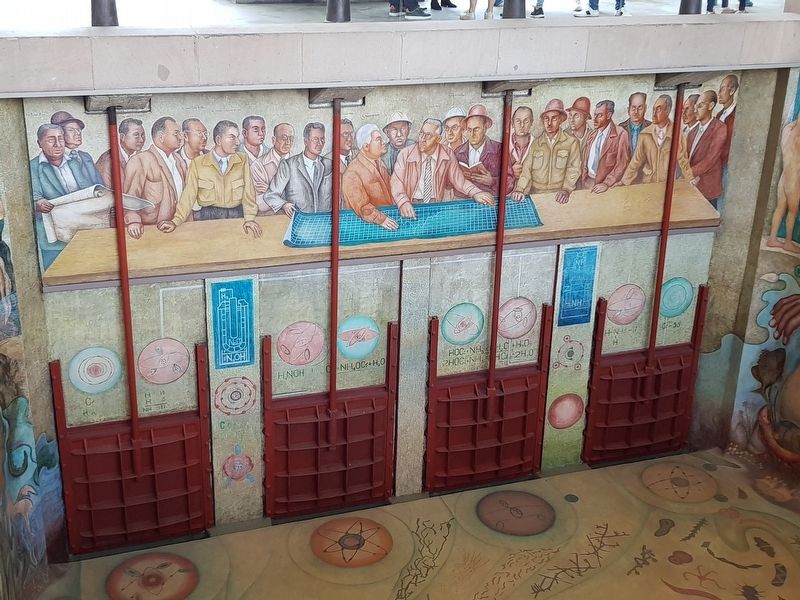
Photographed By J. Makali Bruton, November 30, 2019
4. A portion of the Rivera mural at El Cárcamo de Dólores
This part of the mural is mentioned in the marker text. It shows many of the engineers and scientists that worked on the water distribution system. Note the large metal gates that previously controlled water flow into the water storage area.
Tláloc has two heads: one looks towards the sky and the other looks at the Cárcamo. From inside the building, head and hands form a unit that symbolizes the task of supplying water as a joint effort between Tláloc and human engineering. In the sandals of Tláloc, the history of the hydraulic project is narrated iconographically: on the right foot, a hand and an eagle perched on the cactus work to cross the mountains. On the left sandal, the water finds a route that passes under the mountains.
On the floodgates that supplied the tank with water from the city, Diego Rivera portrays the engineers and architects who worked since 1942 on the project to redirect the waters from the Lerma Basin to Mexico City, through an underground aqueduct 62 kilometers long and 2.5 kilometers wide. The work was inaugurated by President Miguel Aleman in 1951. The depletion of the resources of the Lerma Basin and the overexploitation of the water table, caused a second basin, the Cutzamala, to be used starting in 1976.
The fountain dedicated to Tláloc, lord of the waters in different indigenous cosmogonies, is
designed to be fully appreciated from the sky. Its body, covered with colored stones and tiles, resembles the outline of the mountains. With the left hand, the figure sows corn kernels and with the right hand it offers two ears of corn. Springs, rivers, snakes, fish, a frog, an eagle and nopal, as well as a cornfield, populate the aquatic world from which Tláloc emerges. A huge feathered serpent stands out at the bottom of the fountain: Quetzalcoátl, a deity who, according to Nahua myths, gave corn to men as food.
Diego Rivera projected a mural submerged in water that would give movement to its forms, but over the years the paint deteriorated and detached. To conserve and restore the mural it was necessary to divert the water, which since 1992 does not come into contact with the mural and passes to the sides of the building. On each of the walls are confronted, divided by human archetypes: races, men and women, social classes, the city and the countryside, water as a source of life and wealth, but also joy and beauty.
In the interior mural Diego Rivera interprets the theory of the Russian biologist Alexander Oparín about the origin of life. In the center of the floor, a microscopic look shows how electrical energy animates the mineral elements producing the first cell as well as the most elementary life forms. These are shown multiplying on the walls to form
increasingly complex colonies of the plant and animal kingdom, culminating in the evolution of the human being. A man from Africa and a woman with oriental features represent - according to the fossil record known in the fifties - the first Homo sapiens that inhabited the earth.
The water of the Lerma-Cutzamala system is directed towards a storage and distribution system built in 1909, consisting of four huge tanks with a capacity for fifty million liters of water each and the so-called Lower House. At the beginning of the 20th century, this system received water from the springs of Xochimilco and Chapultepec. Today the Lerma-Cutzamala system supplies water to 30% of the population of the city.
Topics. This historical marker is listed in these topic lists: Anthropology & Archaeology • Arts, Letters, Music • Native Americans • Waterways & Vessels. A significant historical year for this entry is 1950.
Location. 19° 24.758′ N, 99° 11.883′ W. Marker is in Ciudad de México. It is in Colonia Bosque de Chapultepec II Sección. Marker is on Avenida Rodolfo Neri Vela just north of Avenida de los Compositores, on the right. Touch for map. Marker is in this post office area: Ciudad de México 11100, Mexico. Touch for directions.
Other nearby markers. At least 8 other markers are within walking distance of this marker. Francisco I. Madero (approx. 0.6 kilometers away); 12-pounder Napoleon Cannon (approx. 0.7 kilometers away); 24-pounder Howitzer (approx. 0.7 kilometers away); 12-inch Howitzer (approx. 0.7 kilometers away); 24-pounder Cannon (approx. 0.7 kilometers away); 68-pounder Cannon (approx. 0.7 kilometers away); Blakely Cannon (approx. 0.7 kilometers away); Molino de Rey War Memorial (approx. 0.7 kilometers away). Touch for a list and map of all markers in Ciudad de México.
Credits. This page was last revised on February 7, 2023. It was originally submitted on January 11, 2020, by J. Makali Bruton of Accra, Ghana. This page has been viewed 199 times since then and 37 times this year. Photos: 1. submitted on January 12, 2020, by J. Makali Bruton of Accra, Ghana. 2. submitted on January 11, 2020, by J. Makali Bruton of Accra, Ghana. 3, 4, 5, 6. submitted on January 12, 2020, by J. Makali Bruton of Accra, Ghana.
